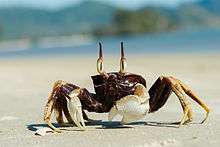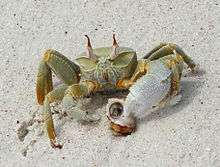Ocypode ceratophthalma
| Ocypode ceratophthalma | |
|---|---|
 | |
| O. ceratophthalma, Krabi, Thailand | |
| Scientific classification | |
| Kingdom: | Animalia |
| Phylum: | Arthropoda |
| Subphylum: | Crustacea |
| Class: | Malacostraca |
| Order: | Decapoda |
| Infraorder: | Brachyura |
| Family: | Ocypodidae |
| Genus: | Ocypode |
| Species: | O. ceratophthalma |
| Binomial name | |
| Ocypode ceratophthalma (Pallas, 1772) [1] | |
| Synonyms | |
| |
Ocypode ceratophthalma, the horned ghost crab[2] or horn-eyed ghost crab,[3] is a species of ghost crab. It lives in the Indo-Pacific region (except the Red Sea); from the coast of East Africa to the Philippines and from Japan to the Great Barrier Reef. They also occur in the Pacific Islands to as far east as Polynesia and Clipperton Island.[4][5] As their common name implies, O. ceratophthalma possess eyestalks extending beyond the eyes into long points,[6] which are longer in adults, and shorter (or even absent) in juveniles. The crabs have a box-shaped body, 6–8 centimetres (2.4–3.1 in) across the carapace, with a darker markings towards the rear in the shape of an H. The outer edges of the eye-sheaths are also sharp and broadly triangular and distinctly pointing sideways in larger individuals.[3][4] O. ceratophthalma can run at speeds of up to 2.1 metres per second (6.9 ft/s).[7]
The characteristic "horned" eyes of O. ceratophthalma are not unique to the species, and it should not be confused with other ghost crabs which also exhibit "horns" on the end of their eyestalks such as O. cursor, O. gaudichaudii, O. macrocera, O. mortoni, O. rotundata, and O. saratan.[4]
Gallery
- Purple O. ceratophthalma on Kailua Beach, Hawaii
 Green O. ceratophthalma on Diego Garcia
Green O. ceratophthalma on Diego Garcia
References
- ↑ Sammy De Grave; N. Dean Pentcheff; Shane T. Ahyong; et al. (2009). "A classification of living and fossil genera of decapod crustaceans" (PDF). Raffles Bulletin of Zoology. Suppl. 21: 1–109.
- ↑ "Ghost crabs". Marine Invertebrates of the National Park of American Samoa. University of Hawaii. November 10, 2009. Retrieved January 2, 2010.
- 1 2 "Horn-eyed ghost crab Ocypode ceratophthalmus". Wild Singapore. May 2009.
- 1 2 3 Katsushi Sakai & Michael Türkay (2013). "Revision of the genus Ocypode with the description of a new genus, Hoplocypode (Crustacea: Decapoda: Brachyura)" (PDF). Memoirs of the Queensland Museum – Nature. 56 (2): 665–793.
- ↑ "Ocypode ceratophthalma (Pallas, 1872) [sic]". Sealifebase. February 25, 2009. Retrieved January 2, 2010.
- ↑ David Gillikin & Anouk Verheyden (November 11, 2002). "Ocypode ceratophthalmus (Pallas)". A field guide to Kenyan mangroves. Retrieved January 2, 2010.
- ↑ Malcolm Burrows & Graham Hoyle (1973). "The mechanism of rapid running in the ghost crab, Ocypode ceratophthalma". Journal of Experimental Biology. 58 (2): 327–349.
External links
 Media related to Ocypode ceratophthalma at Wikimedia Commons
Media related to Ocypode ceratophthalma at Wikimedia Commons